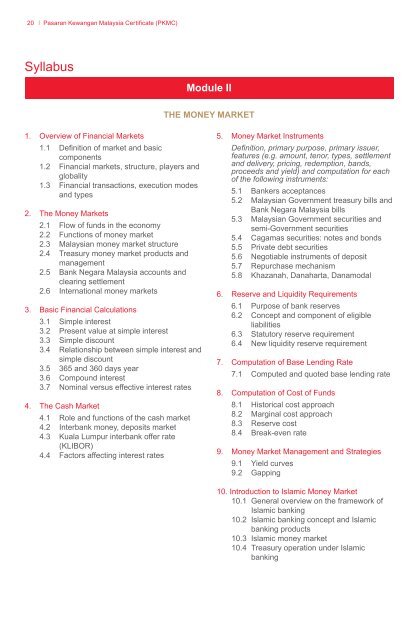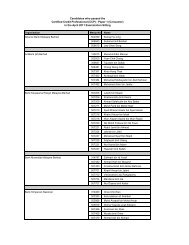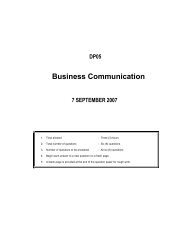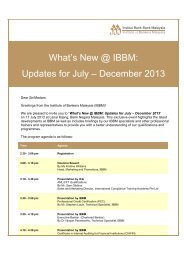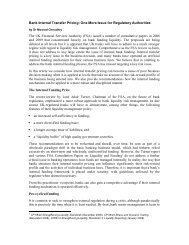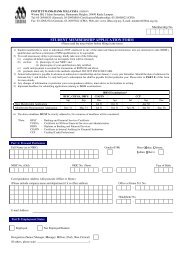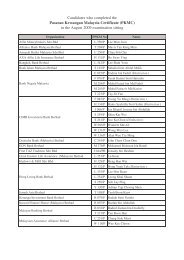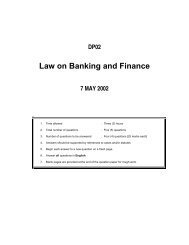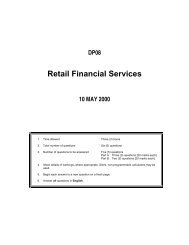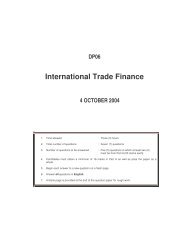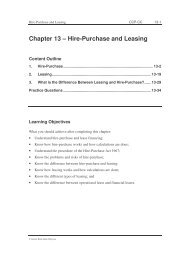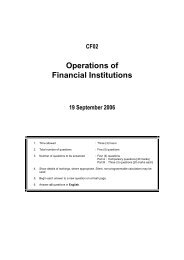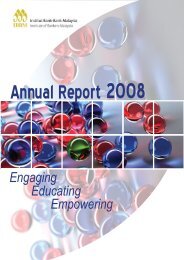Pasaran Kewangan Malaysia Certificate - Institute of Bankers Malaysia
Pasaran Kewangan Malaysia Certificate - Institute of Bankers Malaysia
Pasaran Kewangan Malaysia Certificate - Institute of Bankers Malaysia
You also want an ePaper? Increase the reach of your titles
YUMPU automatically turns print PDFs into web optimized ePapers that Google loves.
20 I <strong>Pasaran</strong> <strong>Kewangan</strong> <strong>Malaysia</strong> <strong>Certificate</strong> (PKMC)<br />
Syllabus<br />
Module II<br />
THE MONEY MARKET<br />
1. Overview <strong>of</strong> Financial Markets<br />
1.1 Definition <strong>of</strong> market and basic<br />
components<br />
1.2 Financial markets, structure, players and<br />
globality<br />
1.3 Financial transactions, execution modes<br />
and types<br />
2. The Money Markets<br />
2.1 Flow <strong>of</strong> funds in the economy<br />
2.2 Functions <strong>of</strong> money market<br />
2.3 <strong>Malaysia</strong>n money market structure<br />
2.4 Treasury money market products and<br />
management<br />
2.5 Bank Negara <strong>Malaysia</strong> accounts and<br />
clearing settlement<br />
2.6 International money markets<br />
3. Basic Financial Calculations<br />
3.1 Simple interest<br />
3.2 Present value at simple interest<br />
3.3 Simple discount<br />
3.4 Relationship between simple interest and<br />
simple discount<br />
3.5 365 and 360 days year<br />
3.6 Compound interest<br />
3.7 Nominal versus effective interest rates<br />
4. The Cash Market<br />
4.1 Role and functions <strong>of</strong> the cash market<br />
4.2 Interbank money, deposits market<br />
4.3 Kuala Lumpur interbank <strong>of</strong>fer rate<br />
(KLIBOR)<br />
4.4 Factors affecting interest rates<br />
5. Money Market Instruments<br />
Definition, primary purpose, primary issuer,<br />
features (e.g. amount, tenor, types, settlement<br />
and delivery, pricing, redemption, bands,<br />
proceeds and yield) and computation for each<br />
<strong>of</strong> the following instruments:<br />
5.1 <strong>Bankers</strong> acceptances<br />
5.2 <strong>Malaysia</strong>n Government treasury bills and<br />
Bank Negara <strong>Malaysia</strong> bills<br />
5.3 <strong>Malaysia</strong>n Government securities and<br />
semi-Government securities<br />
5.4 Cagamas securities: notes and bonds<br />
5.5 Private debt securities<br />
5.6 Negotiable instruments <strong>of</strong> deposit<br />
5.7 Repurchase mechanism<br />
5.8 Khazanah, Danaharta, Danamodal<br />
6. Reserve and Liquidity Requirements<br />
6.1 Purpose <strong>of</strong> bank reserves<br />
6.2 Concept and component <strong>of</strong> eligible<br />
liabilities<br />
6.3 Statutory reserve requirement<br />
6.4 New liquidity reserve requirement<br />
7. Computation <strong>of</strong> Base Lending Rate<br />
7.1 Computed and quoted base lending rate<br />
8. Computation <strong>of</strong> Cost <strong>of</strong> Funds<br />
8.1 Historical cost approach<br />
8.2 Marginal cost approach<br />
8.3 Reserve cost<br />
8.4 Break-even rate<br />
9. Money Market Management and Strategies<br />
9.1 Yield curves<br />
9.2 Gapping<br />
10. Introduction to Islamic Money Market<br />
10.1 General overview on the framework <strong>of</strong><br />
Islamic banking<br />
10.2 Islamic banking concept and Islamic<br />
banking products<br />
10.3 Islamic money market<br />
10.4 Treasury operation under Islamic<br />
banking


